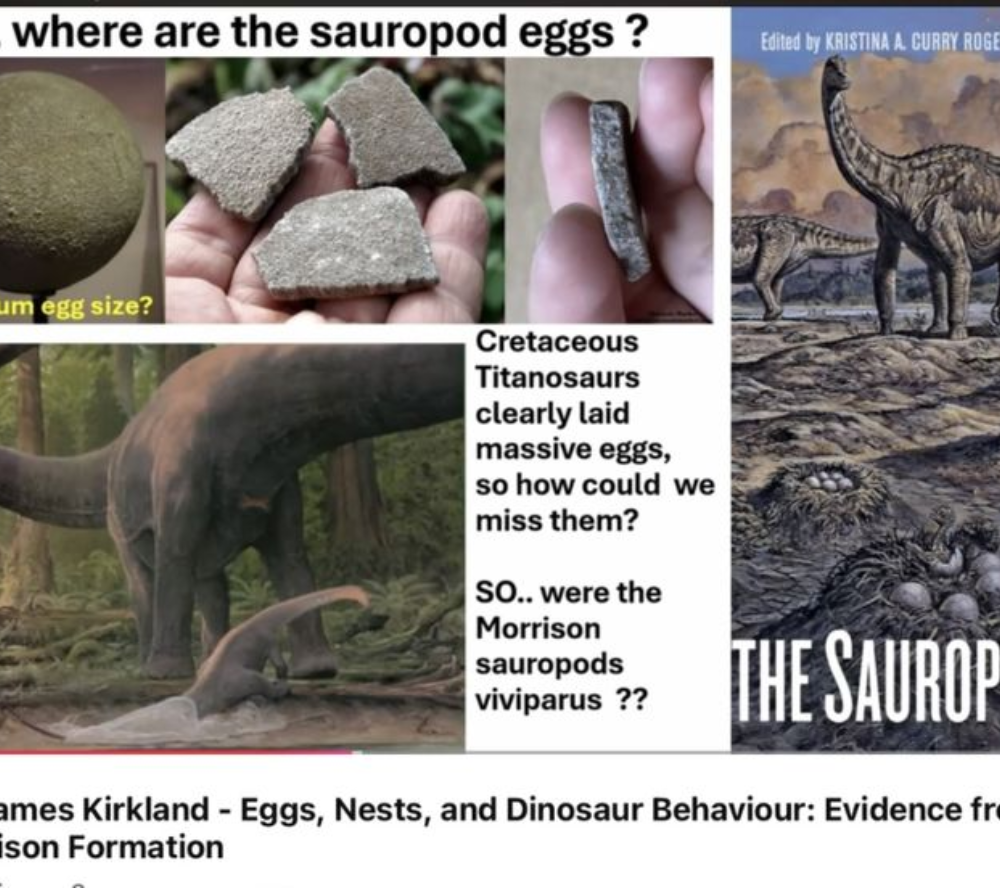Sauropod Eggs Description

The image, titled “SO, where are the sauropod eggs?” features a thought-provoking exploration of sauropod egg fossils and dinosaur behavior, presented by Dr. James Kirkland, with contributions from editors Kristina A. Curry Rogers and others. This educational graphic combines photographs, illustrations, and text to address the rarity of sauropod egg fossils, particularly from the Morrison Formation, and raises intriguing questions about their reproductive strategies. The layout is divided into multiple panels, blending scientific imagery with textual analysis, making it a compelling resource for paleontology enthusiasts and researchers.

Visual and Textual Content
The image is structured with several key elements:
- Title and Question: The bold text “SO, where are the sauropod eggs?” sets the tone, suggesting a mystery about the scarcity of these fossils.
- Egg Fossils:
- A photograph on the left shows a large, spherical fossil labeled “Maximum egg size?” indicating the potential size of sauropod eggs.
- Another image displays fragmented egg shells held in a hand, highlighting their fragile, broken state.
- A third image shows a small, elongated fossil, possibly a piece of an egg or related structure.
- Sauropod Illustration: A detailed drawing on the right depicts two sauropods, likely from the Morrison Formation, standing near a nest with eggs, providing a visual context for their reproductive environment.
- Text Panels:
- A central panel reads, “Cretaceous Titanosaurs clearly laid massive eggs, so why could we miss them? SO… were the Morrison sauropods viviparous??”, posing a hypothesis that sauropods might have given birth to live young rather than laying eggs.
- The bottom left features the title “Dr. James Kirkland – Eggs, Nests, and Dinosaur Behaviour: Evidence from the Morrison Formation,” crediting the research.
- The bottom right includes the book title “THE SAUROPODS,” edited by Kristina A. Curry Rogers and others, indicating a scholarly source.

Scientific Context
- Morrison Formation: This geological formation, known for its rich dinosaur fossils from the Late Jurassic period, is the focus of Dr. Kirkland’s research. The absence of sauropod egg fossils in this region prompts the question of whether these massive dinosaurs (e.g., Diplodocus or Apatosaurus) laid eggs that have yet to be discovered or if they employed viviparity (live birth).
- Cretaceous Titanosaurs: The text references Titanosaurs from the Cretaceous period, which are known to have laid large eggs, suggesting a contrast with the Morrison sauropods and raising the possibility that egg fossils might be overlooked due to their size or preservation conditions.
- Viviparity Hypothesis: The suggestion that Morrison sauropods might have been viviparous challenges traditional views of dinosaur reproduction, offering an alternative explanation for the lack of egg fossils.
Connection to Previous Guides
This sauropod egg exploration complements the earlier posts in your series by continuing the theme of scientific inquiry and skill-building across disciplines:
- Woodworking, Measuring, and Welding Tools: The precision required to identify and study egg fossils mirrors the accuracy needed in woodworking (e.g., using a tape measure for dimensions), measuring (e.g., using a micrometer for fine details), and welding (e.g., using a gauge for structural integrity). The excavation and analysis of fossils also involve tools akin to those in these crafts.
- Pterosaur Fossil: This post directly aligns with the pterosaur fossil guide, both focusing on dinosaur-related paleontology. While the pterosaur guide detailed skull anatomy, this one explores reproductive evidence, broadening the understanding of dinosaur life cycles.
- Drawing Tutorials (JeYRam, Loomis, Shozart, Flames, Rocks): The artistic skills developed in these tutorials—such as rendering three-dimensional forms (Loomis/Shozart), organic shapes (flames), and textured surfaces (rocks)—are relevant to illustrating sauropods and their nests. The rock-drawing tutorial, in particular, connects to the depiction of the Morrison Formation’s geological context.
Educational Value and Context
Authored by Dr. James Kirkland, a noted paleontologist, and featured in “The Sauropods” edited by Kristina A. Curry Rogers, this image reflects cutting-edge research into dinosaur behavior. The combination of photographic evidence and speculative text encourages critical thinking about fossil records and reproductive strategies. The question of viviparity versus oviparity in sauropods adds a layer of intrigue, making this a thought-provoking addition to your website’s content.
Captured as of 11:15 PM EDT on Saturday, June 07, 2025, this guide enhances your collection with a scientific perspective, bridging paleontology with the observational and artistic skills highlighted in previous posts.
